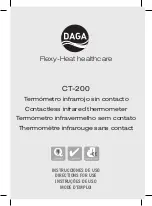
50
Note
: The DTA has a predefined value that is already set and is optimal for most installation applications;
if you change it, bear in mind that, if there are considerable variations in temperature around the set
threshold value, too low a value assigned to the DTA could cause numerous SMS alarm messages to
be sent out�
The SMS alarm message is formed in this way:
Temperature alarm!
Tmis: <temperature value>
Tinf: <lower temperature threshold value>
+
Address (option)
Note
: The higher and lower temperature alarms are independent of each other; it is therefore possible
to enable only one of them (for example only the lower one), both or none�
The configuration operations that, via SMS, can be performed on this alarm message are given in the
following points�
13.6.3.1 Enabling or disabling lower temperature alarm management
This option, if enabled, allows the chronothermostat to check the measured temperature continuously
in order to detect any decrease with respect to the set lower threshold value and warn the user about
it with an SMS message�
To enable it, send the following SMS message:
<user code>.ATEMP.AT0.ON
Note:
No response SMS message is required from the chronothermostat 01913�
Example�
If the set user code is the default 1234 and you want to enable management of the alarm for the
temperature being lower than the threshold Tinf, send the following SMS:
1234.ATEMP.AT0.ON
To disable it, send the following SMS message:
<user code>.ATEMP.AT0.OFF
Note
: No response SMS message is required from the chronothermostat 01913�
Example�
If the set user code is the default 1234 and you want to disable management of the alarm for the
temperature being lower than the threshold Tinf, send the following SMS:
1234.ATEMP.AT0.OFF
















































